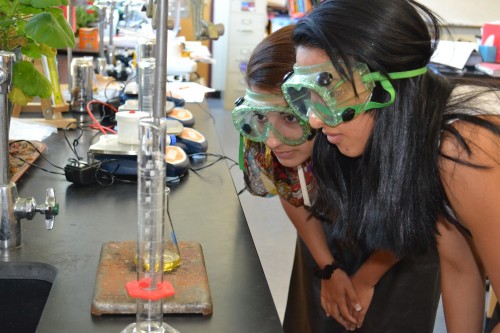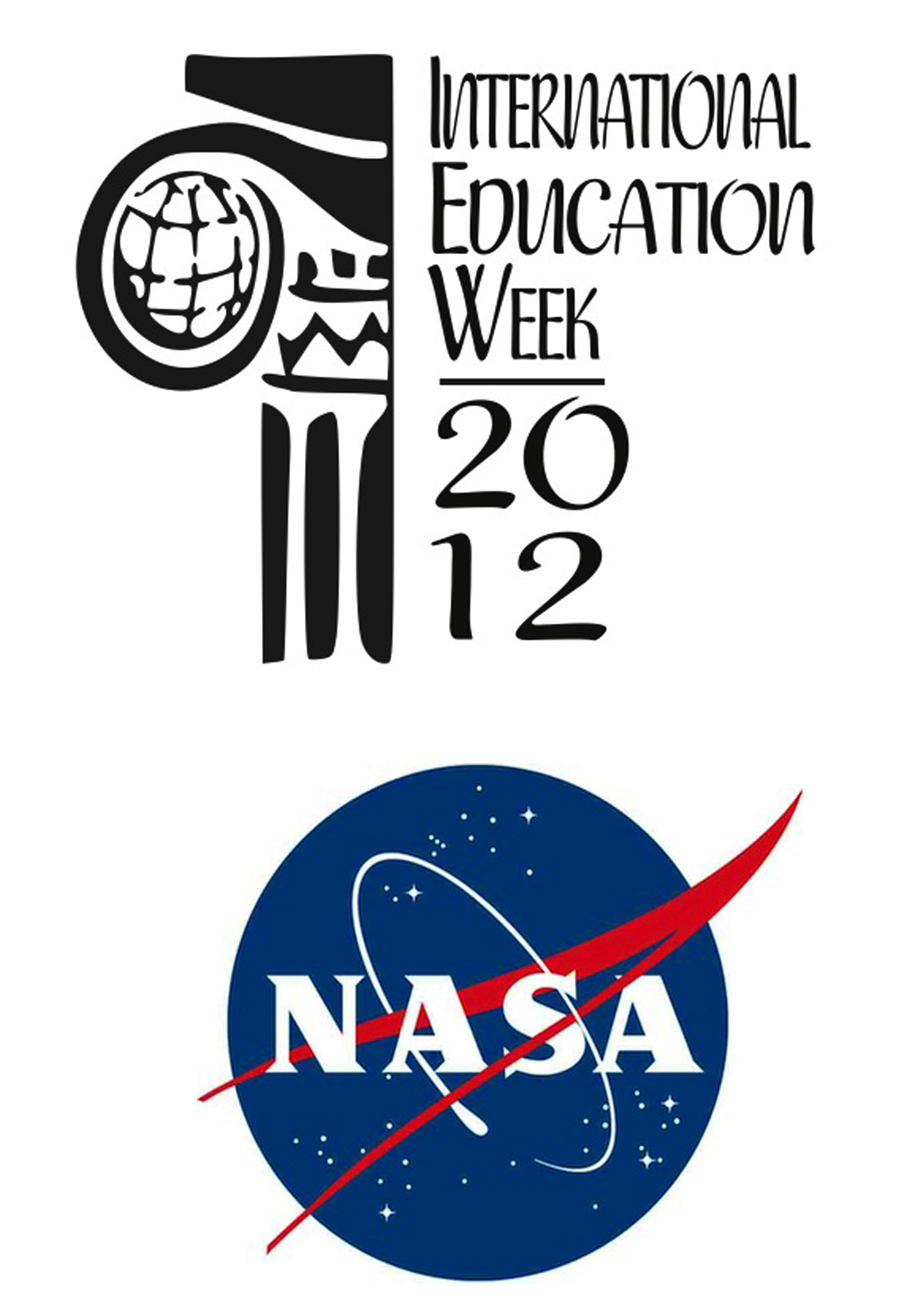Return to ISS Webcast Main page

Fitchburg, MA: Student Spaceflight Experiments Program grade 11 researchers Nadia Machado and Yeniffer Araujo run titrations as they conduct preliminary tests on their flight experiment, which is currently aboard ISS: Will Microgravity Have a Significant Affect on Packed Synthetic HBOCs? Click for Zoom
This page provides content resources and ideas that teachers can use to embed the November 15, 2012, webcast from the International Space Station (ISS) into wider classroom discussions over a broad range of topics in space science, space flight, human exploration, and the interdisciplinary nature of learning. If you don’t have time to use these resources before the webcast, you ca use them afterward with the webcast serving as the launch point for further exploration. Resources include short videos, essays, and inquiry-based hands-on activities.
Section 1 below provides an understanding of how thousands of SSEP student teams across the U.S. and Canada began their adventure in real research, first with an understanding of microgravity (‘weightlessness’), and then with a well-defined approach to microgravity experiment design. Section 1 includes a great hands-on activity that truly demonstrates ‘weightlessness’ in the classroom.
In Sections 2 and 4 you’ll find video clips and essays on various topics with essential questions, some with hands-on activities, that were written by Dr. Jeff Goldstein, Center Director of the National Center for Earth and Space Science Education (NCESSE), and Program Director for the Student Spaceflight Experiments Program. Section 3 provides links to NASA online education resources with a focus on the International Space Station.
1. Understanding Microgravity, and How Students Approach the Design of Microgravity Experiments for the International Space Station—Straightforward Concepts
The way to think about the SSEP flight experiment opportunity is pretty simple, and appropriate for even upper elementary and middle school students—if teachers help them put on their thinking caps. It is worth noting that of the 50 experiments chosen to fly on the first 4 SSEP flight opportunities (STS-134 and STS-135, and Missions 1 and 2 to ISS) 8 were from upper elementary, 18 were from middle school, and 24 were from high school / community college student teams.
In terms of experimental design, the essential question is:
What phenomenon associated with a physical, chemical, or biological system would I like to explore
with gravity seemingly turned off for a period of time?
We normally observe the characteristics and processes of physical, chemical, and biological systems under the action of gravity on or near the surface of Earth. These systems all experience the “force of gravity” which dictates a number of fundamental phenomena, e.g., that objects and materials weigh something, a sense of up versus down, and that lower density materials will float on higher density materials. These phenomena are intricately connected with how systems behave, and in biological systems, are fundamental to their function (e.g., bone strength requires bone compression under the force of gravity—without it, as in orbit, bone mass is excreted, because it is no longer needed.) Revealing gravity’s role in the behavior of a system can provide a fundamental understanding of how the system operates. More>
2. Essays, Videos, and Activities with Direct Content Connections to the Webcast Experience
a. VIDEO: Human Exploration the Journey Continues
Video playlist for the keynote address for the Student Spaceflight Experiments Program National Conference, Milestones of Flight gallery, Smithsonian National Air and Space Museum, July 2012
Essential Question: What is the nature of human exploration?
b. The Business Trip
Essential Questions: How far is ‘Outer Space’? Where is the International Space Station? What does this imply for the thickness of Earth’s atmosphere?
Concepts: the location of an orbiting space station; speed of space station; orbiting spacecraft are in outer space, above Earth’s atmosphere
Objective: to recognize that orbiting spacecraft are closer to the surface of Earth than you are to places you’ve traveled by car; given these spacecraft are in “outer space”, they are above the atmosphere—which must be a slender veil of air surrounding the planet.
Math skills: relation: distance = speed x time
Special features: includes a classroom activity using the web to: research geographic locations that are the same distance as outer space; online tracking of the shuttle and the space station to see when you can see them flying overhead, and recognize that you’re seeing an object far above Earth’s atmosphere.
c. Apples and You
Essential Question: How thick is Earth’s atmosphere?
Concepts: use of a physical model as a learning tool; the atmosphere supports life on Earth; human activity is changing the atmosphere; global warming
Objectives: to create a physical model of the atmosphere; to have an interdisciplinary discussion on global warming; to understand how astronauts perceive the atmosphere from space
Math skills: ratios; measurement; experimental design
Special features: hands-on activity; interdisciplinary connections
d. Scientists and Engineers as Heroes and Role Models: We need new heroes for the 21st century.
Essential Question: Can scientists and engineers be heroes and role models too?
e. An Apollo 11 Personal Story, A Chance Encounter with Buzz Aldrin
Essential Question: What is it like to meet your hero? What is the nature of human exploration?
3. NASA Educational Resources on the International Space Station
A Day in the Life Aboard the International Space Station – short, on-orbit demos of astronauts demonstrating what it is like to live and work in space – http://www.nasa.gov/education/tfs/dil
Teach Station – space station-focused education resources, science and research information for students and teachers, crew updates, and video clips of STEM concepts in orbit (STEM on Station in left navigation) – http://www.nasa.gov/education/teachstation
4. Resources Over a Broader Range of Topics in Space Science, Human Exploration, and Learning
a. The Nature of Our Existence: Celebrating what we know of Earth in a greater space—and that we can know it.
Essential Question: Where is Earth in the Universe?
b. The Art of Teaching: A thank you to teachers everywhere.
Essential Question: What is it like to be a teacher, and link each generation to the next?
VIDEO: We’ve Got to be That Light, a Music Video for Teachers Everywhere
c. The Power of Models
Essential Question: What are the most important tools for human exploration and learning? (Models)
d. Mathematics Education: Math is a language … the language of nature.
Essential Questions: Why should I learn mathematics? Will I ever use it?
e. My Really Long Drive with Jordi
Essential Question: How can we make Solar System sizes and distances (like the size of Earth, the size of the Sun, and distances to the Moon and Sun) understandable?
f. If I Could Gift Wrap the Moon
Essential Question: How big is the Moon?
g. The Milky Way: Our City of Stars
Essential Question: How many stars are there?


